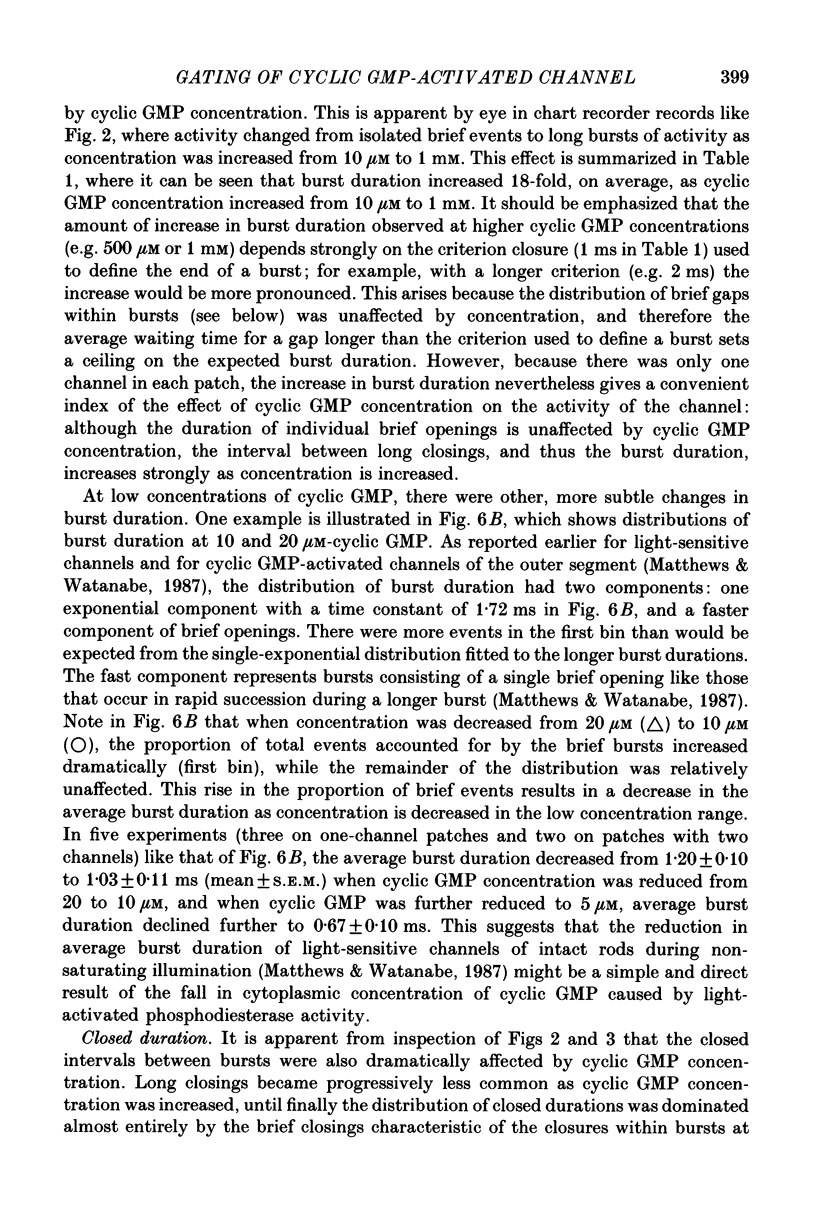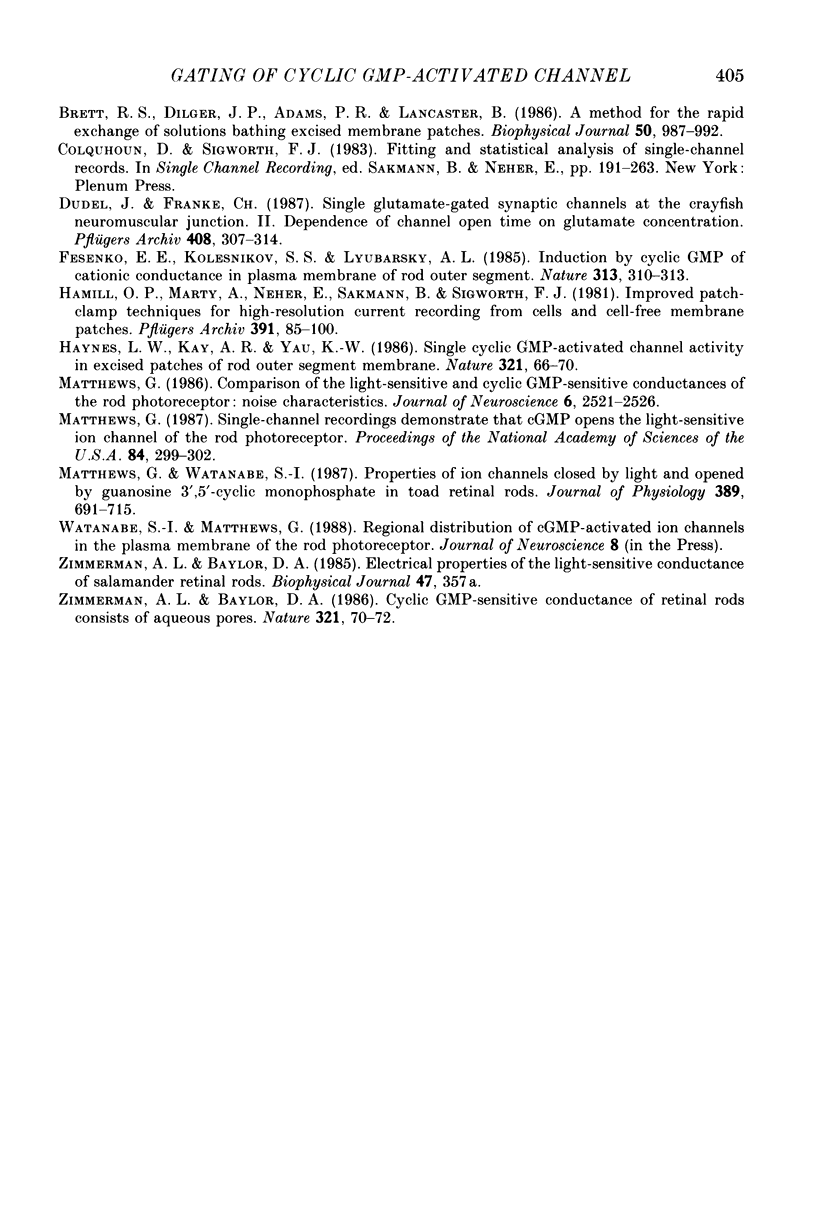Abstract
1. Patch-clamp recordings of single cyclic GMP-activated channels from toad rod photoreceptors were made in inside-out membrane patches containing only one such channel. Patches were obtained from the inner segment, where the density of cyclic GMP-activated channels is lower than in the outer segment, making one-channel patches possible. The dependence of channel gating on cyclic GMP concentration ([cyclic GMP]) was studied. At low [cyclic GMP] (5-10 microM), channel openings were infrequent and occurred as bursts of rapid opening and closing. As [cyclic GMP] was increased, bursts became more frequent, until at 1 mM the activity fused into long bouts of rapid flicker between open and closed states. 2. The duration of brief openings and closings (flicker) within bursts was not affected by [cyclic GMP]. This suggests that the rapid flicker within bursts results from an intrinsic channel property not associated with agonist-induced receptor activation. 3. At 10 microM-cyclic GMP, the distribution of closed times was fitted by a sum of three exponential components. The briefest, with time constant averaging 0.29 ms, corresponded to the brief closings within bursts, while the two longer components, with time constants averaging 3.5 and 32 ms, corresponded to much longer closings between bursts. At 0.5 or 1 mM-cyclic GMP (saturation), the longer components disappeared, and the distribution of closed times was fitted by a single-exponential equation with the same time constant as the briefest component observed at lower concentrations. 4. Because the channel continued to flicker even at high [cyclic GMP], the maximal probability of being in the open state (Po) did not approach 1.0, averaging 0.30 +/- 0.05 (N = 8). The relation between Po and [cyclic GMP] was fitted by the Hill equation with an exponent of 3, suggesting that binding of cyclic GMP to multiple sites is required to open the channel.
Full text
PDF
















Selected References
These references are in PubMed. This may not be the complete list of references from this article.
- Bader C. R., Bertrand D., Schwartz E. A. Voltage-activated and calcium-activated currents studied in solitary rod inner segments from the salamander retina. J Physiol. 1982 Oct;331:253–284. doi: 10.1113/jphysiol.1982.sp014372. [DOI] [PMC free article] [PubMed] [Google Scholar]
- Baylor D. A., Lamb T. D., Yau K. W. The membrane current of single rod outer segments. J Physiol. 1979 Mar;288:589–611. [PMC free article] [PubMed] [Google Scholar]
- Baylor D. A., Matthews G., Yau K. W. Two components of electrical dark noise in toad retinal rod outer segments. J Physiol. 1980 Dec;309:591–621. doi: 10.1113/jphysiol.1980.sp013529. [DOI] [PMC free article] [PubMed] [Google Scholar]
- Brett R. S., Dilger J. P., Adams P. R., Lancaster B. A method for the rapid exchange of solutions bathing excised membrane patches. Biophys J. 1986 Nov;50(5):987–992. doi: 10.1016/S0006-3495(86)83539-1. [DOI] [PMC free article] [PubMed] [Google Scholar]
- Dudel J., Franke C. Single glutamate-gated synaptic channels at the crayfish neuromuscular junction. II. Dependence of channel open time on glutamate concentration. Pflugers Arch. 1987 Mar;408(3):307–314. doi: 10.1007/BF02181474. [DOI] [PubMed] [Google Scholar]
- Fesenko E. E., Kolesnikov S. S., Lyubarsky A. L. Induction by cyclic GMP of cationic conductance in plasma membrane of retinal rod outer segment. Nature. 1985 Jan 24;313(6000):310–313. doi: 10.1038/313310a0. [DOI] [PubMed] [Google Scholar]
- Hamill O. P., Marty A., Neher E., Sakmann B., Sigworth F. J. Improved patch-clamp techniques for high-resolution current recording from cells and cell-free membrane patches. Pflugers Arch. 1981 Aug;391(2):85–100. doi: 10.1007/BF00656997. [DOI] [PubMed] [Google Scholar]
- Haynes L. W., Kay A. R., Yau K. W. Single cyclic GMP-activated channel activity in excised patches of rod outer segment membrane. Nature. 1986 May 1;321(6065):66–70. doi: 10.1038/321066a0. [DOI] [PubMed] [Google Scholar]
- Matthews G. Comparison of the light-sensitive and cyclic GMP-sensitive conductances of the rod photoreceptor: noise characteristics. J Neurosci. 1986 Sep;6(9):2521–2526. doi: 10.1523/JNEUROSCI.06-09-02521.1986. [DOI] [PMC free article] [PubMed] [Google Scholar]
- Matthews G. Single-channel recordings demonstrate that cGMP opens the light-sensitive ion channel of the rod photoreceptor. Proc Natl Acad Sci U S A. 1987 Jan;84(1):299–302. doi: 10.1073/pnas.84.1.299. [DOI] [PMC free article] [PubMed] [Google Scholar]
- Matthews G., Watanabe S. Properties of ion channels closed by light and opened by guanosine 3',5'-cyclic monophosphate in toad retinal rods. J Physiol. 1987 Aug;389:691–715. doi: 10.1113/jphysiol.1987.sp016678. [DOI] [PMC free article] [PubMed] [Google Scholar]
- Zimmerman A. L., Baylor D. A. Cyclic GMP-sensitive conductance of retinal rods consists of aqueous pores. Nature. 1986 May 1;321(6065):70–72. doi: 10.1038/321070a0. [DOI] [PubMed] [Google Scholar]


